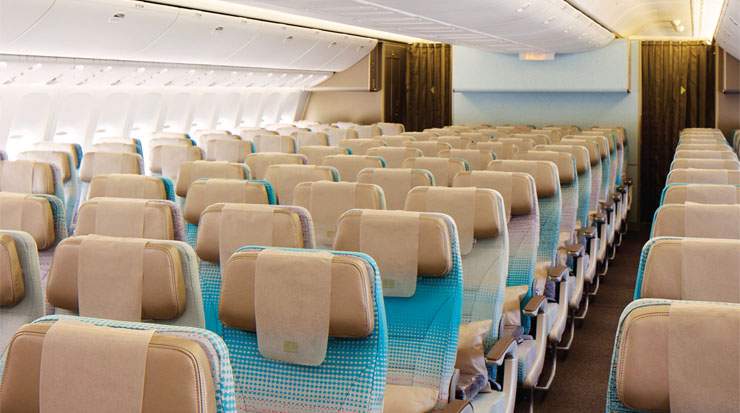There is a lot for the discerning traveller to consider when booking a flight and, keeping in mind consumers’ growing needs and demands, airlines are aware they must stay ahead of the game to maintain a competitive edge.
Several MENA-based airlines have become global industry leaders in adapting to provide innovative new products and services to their clients, as the sector continues to grow on both a regional and global level.
BRIGHT OUTLOOK
It is clear to see why airlines are working hard to maintain and expand their market share as there are significant indications the airline sector will continue to expand on a global level, as well as within the MENA region specifically.
International Air Transport Association (IATA), at the end of 2017, for example, provided an encouraging outlook for the global airline industry.
Anticipating a strong demand for air travel, IATA predicted global net profit of USD38.4 billion for the industry this year, much higher than the profitability forecast of USD34.5 billion for 2017.
Ratings agency Moody’s, meanwhile, suggested the Middle East would be the fastest-growing region of the world for the airline industry in 2017.
Additionally, in its 2017 Global Aerospace and Defence Sector Outlook report, Deloitte, an audit, consulting, tax, and advisory service, noted that the Middle East region had led travel demand growth globally between 2010 and 2015, and was also expected to continue to record the highest Revenue Passengers Kilometres (RPK) growth in 2016.
Deloitte added that, over the following 20 years, passenger traffic growth was forecast to grow strongly at an annual rate of 5.9 percent and that the region would need 3,310 additional aircraft to meet the increasing demand.
Taking all this into account, two of MENA’s leading airlines recently revealed how they are working to keep their clients happy and their competitors on their toes.
ADAPTING TO DEMANDS
Thierry Aucoc, senior vice president, commercial operations, Europe and Russia, Emirates, disclosed, “Emirates will always remain a full-service airline with a rich product offering, but we will continue to look at different ways to offer more value for money options for our customers.”
This, according to Aucoc, includes adjusting to unbundling in order to offer customers more choices. Now, Emirates passengers can choose from a variety of seat options, different ticket fare options depending on the best fit for their journey, and can pay to enter the airline’s airport lounges regardless of which cabin class they travel in.
“We are also seeing demand for airlines to become more digitally present, to which we have responded with our redesigned mobile app and web experience which includes a more simplified booking and check-in process as well as live chat options,” Aucoc added.
Unveiling Gulf Air’s strategy and plans for this year and beyond, Krešimir Kučko, CEO, Gulf Air, revealed the airline is also moving with the times, including investing in its fleet renewal.
Bahrain’s national carrier is anticipated to welcome an incoming fleet of 39 new Boeing and Airbus aircraft, which are expected to commence delivery over the coming months. A total of seven new aircraft, five Boeing B787-9 Dreamliners and two Airbus A320neo aircraft, are anticipated to enter the airline’s fleet before the end of the year.
GAME-CHANGING UPGRADES
Kučko outlined that Gulf Air’s new fleet would be outfitted with superior on-board products and services including, what he described as, some of the best in-class seats and in-flight entertainment options. The airline is also aiming to create a new business class offering that would compete with the first class standard of other airlines, and a fresh economy class product that would afford enhanced onboard comfort.
Additionally, Emirates has also introduced product enhancements on both its Boeing B777 and Airbus A380 aircrafts, while it has also unveiled an enhanced A380 onboard lounge. Its Boeing B77-300ER first class private suites have experienced, what Aucoc described as a multi-million-dollar game-changing upgrade. Aucoc noted that Emirates recently announced a new business class cabin configuration on its Boeing B777-200LR aircraft with wider seats in a 2-2-2 configuration for the very first time.
Economy class seats on the B777-200LRs have also been refreshed with full leather headrests with flexible side panels that can be adjusted for optimum support. Also, within Emirates’ economy class cabins, the airline has introduced sustainable blankets made from 100 percent recycled plastic bottles, hailed as the largest onboard sustainable blanket programme in the airline industry.
Illustrating its pioneering role, Emirates, in 1992, became the first airline to install TV screens on every seat, and in 2017 it connected over 10 million passengers to Wi-Fi onboard its flights. Its in-flight entertainment system, ice, now provides passengers with over 3,500 channels live TV.
CHAMPIONING CONNECTIVITY
Providing customer comfort is one thing but they also need to be encouraged to get onboard to try out the immersive experiences, and one of the most effective means of doing this is efficiently getting them where they want to go.
“We continue to find ways to meet customer demand with even more convenient flight options,” added Aucoc. “In July 2017, we entered a partnership with [Dubai low-cost carrier] flydubai, which offers passengers access to over 200 destinations through the combined network of the airlines.”
Gulf Air also recognises the importance of connectivity. Kučko outlined that Gulf Air planned to add eight new destinations to its network this year. Alongside this, frequency changes to key routes during the course of the year are
anticipated to enhance Gulf Air’s network to and from Bahrain.
LOOKING AHEAD
Aucoc expressed confidence that the airline industry will continue to grow, as demand for global travel increases, especially within regions like Africa, the Middle East and Asia, particularly China, which he described as fast becoming one of the world’s largest air travel markets.
Kučko also spoke of upcoming plans to rollout a new brand identity for the airline, noting that the new look and feel for Gulf Air would, alongside its new fleet, new network, new products and services, represent the Gulf Air of Tomorrow.









